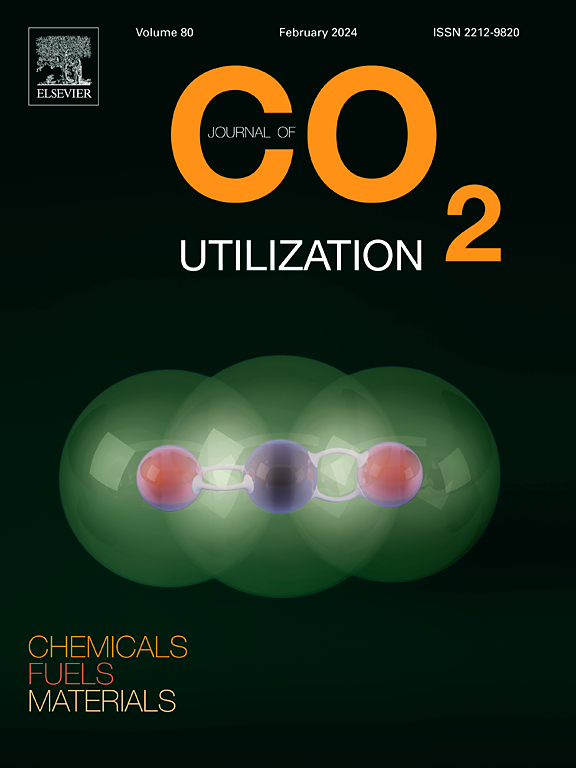Electrochemical reduction of CO2 by In doped- SnO2 nanoparticles with high stability and activity toward selective formic acid formation
IF 8.4
2区 工程技术
Q1 CHEMISTRY, MULTIDISCIPLINARY
引用次数: 0
Abstract
SnO2 catalysts have been identified as active electrocatalysts for formate (HCOO─) production in electrochemical CO2 reduction reactions (eCO2RR). Nevertheless, it is a tremendous challenge to develop SnO2 that is durable under the working conditions of eCO2RR. Here, we present an effective method for the development of indium-doped SnO2 porous nanoparticles (In (X%) - SnO2 (NPs)), which are effective electrocatalysts for elevating CO2 reduction to HCOO-. We prepared In (X%)-SnO2 (NPs) with a minimal content of In (≤ 5 %) via the facile evaporation-induced co-assembly (EICA) approach followed by calcination under N2 and Air atmosphere. Compared with bare SnO2 (NPs), In(1 %)-SnO2 (NPs) exhibits a significantly enhanced CO2 reduction activity with a higher partial current density at −1.2 V vs RHE (-23.56 mA cm−2), and higher faradic efficiency (∼98 %) for formic acid production at a wide range of potential (-0.9 to −1.2) V vs RHE. Moreover, the In(1 %)-SnO2 (NPs) also showed excellent stability for over 50 h and a higher faradic efficiency of 95 % at −0.93 V vs RHE for formate production. It is believed that the porous structure of In(X%)-SnO2 (NPs) contributes to the enhanced faradic efficiency and stability, and the uniform surface activation of Sn-In/SnO2 on a homogeneously distributed In(X%)-SnO2 (NPs) crystal leads to an increase in surface area, oxygen vacancies, electron transfer efficiency, and catalytic activity for eCO2RR. This approach, which incorporates a porous structure, oxygen vacancies, and element doping, provides an effective route for developing highly active electrocatalysts and enhancing electrocatalytic performance.
具有高稳定性和选择性甲酸形成活性的In掺杂SnO2纳米颗粒电化学还原CO2
SnO2催化剂是电化学CO2还原反应(eCO2RR)中生成甲酸酯(HCOO)的活性电催化剂。然而,开发在eCO2RR工作条件下耐用的SnO2是一个巨大的挑战。在这里,我们提出了一种有效的方法来开发铟掺杂的SnO2多孔纳米颗粒(In (X%) - SnO2 (NPs)),它是将CO2还原为HCOO-的有效电催化剂。我们采用易蒸发诱导共组装(EICA)方法,在N2和空气气氛下煅烧制备了In (X%)-SnO2 (NPs),其In含量最低(≤5 %)。与裸SnO2 (NPs)相比,In(1 %)-SnO2 (NPs)表现出显著增强的CO2还原活性,在−1.2 V vs RHE(-23.56 mA cm−2)下具有更高的分电流密度,在宽电位范围(-0.9至−1.2)V vs RHE下具有更高的甲酸生成效率(~ 98 %)。此外,In(1 %)-SnO2 (NPs)也表现出超过50 h的优异稳定性,并且在−0.93 V vs RHE下具有95 %的较高的法进效率。In(X%)-SnO2 (NPs)的多孔结构有助于提高faradic效率和稳定性,并且Sn-In/SnO2在均匀分布的In(X%)-SnO2 (NPs)晶体上的均匀表面活化导致了eCO2RR的表面积、氧空位、电子转移效率和催化活性的增加。该方法结合了多孔结构、氧空位和元素掺杂,为开发高活性电催化剂和提高电催化性能提供了有效途径。
本文章由计算机程序翻译,如有差异,请以英文原文为准。
求助全文
约1分钟内获得全文
求助全文
来源期刊

Journal of CO2 Utilization
CHEMISTRY, MULTIDISCIPLINARY-ENGINEERING, CHEMICAL
CiteScore
13.90
自引率
10.40%
发文量
406
审稿时长
2.8 months
期刊介绍:
The Journal of CO2 Utilization offers a single, multi-disciplinary, scholarly platform for the exchange of novel research in the field of CO2 re-use for scientists and engineers in chemicals, fuels and materials.
The emphasis is on the dissemination of leading-edge research from basic science to the development of new processes, technologies and applications.
The Journal of CO2 Utilization publishes original peer-reviewed research papers, reviews, and short communications, including experimental and theoretical work, and analytical models and simulations.
 求助内容:
求助内容: 应助结果提醒方式:
应助结果提醒方式:


